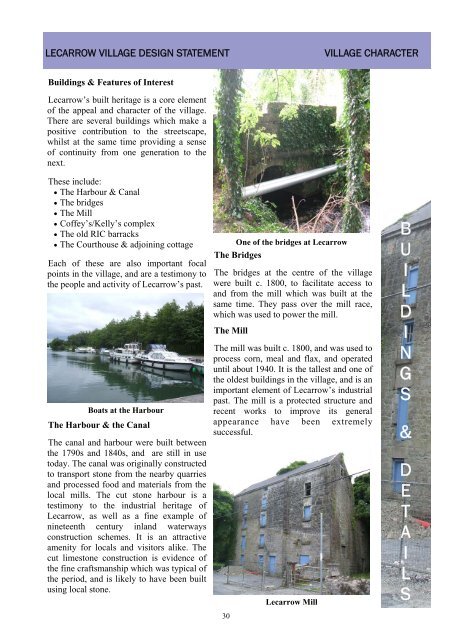Final Lecarrow Village Design Statement - Roscommon County ...
Final Lecarrow Village Design Statement - Roscommon County ...
Final Lecarrow Village Design Statement - Roscommon County ...
Create successful ePaper yourself
Turn your PDF publications into a flip-book with our unique Google optimized e-Paper software.
LECARROW VILLAGE DESIGN STATEMENT<br />
VILLAGE CHARACTER<br />
Buildings & Features of Interest<br />
<strong>Lecarrow</strong>’s built heritage is a core element<br />
of the appeal and character of the village.<br />
There are several buildings which make a<br />
positive contribution to the streetscape,<br />
whilst at the same time providing a sense<br />
of continuity from one generation to the<br />
next.<br />
These include:<br />
• The Harbour & Canal<br />
• The bridges<br />
• The Mill<br />
• Coffey’s/Kelly’s complex<br />
• The old RIC barracks<br />
• The Courthouse & adjoining cottage<br />
Each of these are also important focal<br />
points in the village, and are a testimony to<br />
the people and activity of <strong>Lecarrow</strong>’s past.<br />
Boats at the Harbour<br />
The Harbour & the Canal<br />
The canal and harbour were built between<br />
the 1790s and 1840s, and are still in use<br />
today. The canal was originally constructed<br />
to transport stone from the nearby quarries<br />
and processed food and materials from the<br />
local mills. The cut stone harbour is a<br />
testimony to the industrial heritage of<br />
<strong>Lecarrow</strong>, as well as a fine example of<br />
nineteenth century inland waterways<br />
construction schemes. It is an attractive<br />
amenity for locals and visitors alike. The<br />
cut limestone construction is evidence of<br />
the fine craftsmanship which was typical of<br />
the period, and is likely to have been built<br />
using local stone.<br />
The Bridges<br />
The bridges at the centre of the village<br />
were built c. 1800, to facilitate access to<br />
and from the mill which was built at the<br />
same time. They pass over the mill race,<br />
which was used to power the mill.<br />
The Mill<br />
The mill was built c. 1800, and was used to<br />
process corn, meal and flax, and operated<br />
until about 1940. It is the tallest and one of<br />
the oldest buildings in the village, and is an<br />
important element of <strong>Lecarrow</strong>’s industrial<br />
past. The mill is a protected structure and<br />
recent works to improve its general<br />
appearance have been extremely<br />
successful.<br />
30<br />
One of the bridges at <strong>Lecarrow</strong><br />
<strong>Lecarrow</strong> Mill<br />
B<br />
U<br />
I<br />
L<br />
D<br />
I<br />
N<br />
G<br />
S<br />
&<br />
D<br />
E<br />
T<br />
A<br />
I<br />
L<br />
S
















